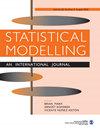多元函数加性混合模型
IF 1.2
4区 数学
Q2 STATISTICS & PROBABILITY
引用次数: 8
摘要
多元功能数据本质上可以是多元的,如二维的运动轨迹或互补的,如给定气象站随时间的降水、温度和风速。我们提出了一个多元功能加性混合模型(multiFAMM),并通过运动科学(斯诺克运动员的运动轨迹)和语音学(声学信号和辅音发音)的例子展示了它在两种数据情况下的应用。该方法包括线性和非线性协变量效应,并使用多变量泛函主成分分析对响应维度之间的依赖结构进行建模。多变量函数随机截距捕获给定函数内的自相关性和多变量函数维度之间的交叉相关性。它们还允许我们模拟由重复测量或交叉研究设计等引起的功能间相关性。对维度之间的依赖结构进行建模可以对多元函数过程的属性产生额外的见解,改进随机效应的估计,并为协变量效应产生校正的置信带。大量的仿真研究表明,多元建模方法比在保持或改善模型拟合的同时对数据拟合独立的单变量模型更为简洁。本文章由计算机程序翻译,如有差异,请以英文原文为准。
Multivariate functional additive mixed models
Multivariate functional data can be intrinsically multivariate like movement trajectories in 2D or complementary such as precipitation, temperature and wind speeds over time at a given weather station. We propose a multivariate functional additive mixed model (multiFAMM) and show its application to both data situations using examples from sports science (movement trajectories of snooker players) and phonetic science (acoustic signals and articulation of consonants). The approach includes linear and nonlinear covariate effects and models the dependency structure between the dimensions of the responses using multivariate functional principal component analysis. Multivariate functional random intercepts capture both the auto-correlation within a given function and cross-correlations between the multivariate functional dimensions. They also allow us to model between-function correlations as induced by, for example, repeated measurements or crossed study designs. Modelling the dependency structure between the dimensions can generate additional insight into the properties of the multivariate functional process, improves the estimation of random effects, and yields corrected confidence bands for covariate effects. Extensive simulation studies indicate that a multivariate modelling approach is more parsimonious than fitting independent univariate models to the data while maintaining or improving model fit.
求助全文
通过发布文献求助,成功后即可免费获取论文全文。
去求助
来源期刊

Statistical Modelling
数学-统计学与概率论
CiteScore
2.20
自引率
0.00%
发文量
16
审稿时长
>12 weeks
期刊介绍:
The primary aim of the journal is to publish original and high-quality articles that recognize statistical modelling as the general framework for the application of statistical ideas. Submissions must reflect important developments, extensions, and applications in statistical modelling. The journal also encourages submissions that describe scientifically interesting, complex or novel statistical modelling aspects from a wide diversity of disciplines, and submissions that embrace the diversity of applied statistical modelling.
 求助内容:
求助内容: 应助结果提醒方式:
应助结果提醒方式:


